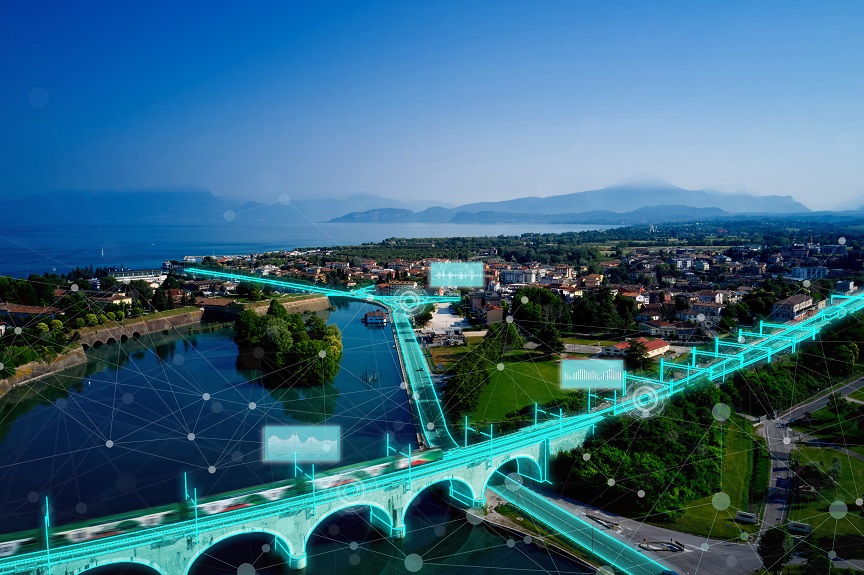Earlier this year work began on the first masonry arch project ever undertaken by Bridges to Prosperity: the bridge is located in the Rwandan District of Musanze, Northern Province, and works are still in the early stages of ground clearing and foundation work. At a modest 6m in length, this arch bridge is a far cry from the kinds of spans the non-profit organisation is renowned for, but it could mark the beginning of an exciting new chapter for an organisation that to date has provided safe access to over 2 million people.
Since its foundation 23 years ago, Bridges to Prosperity (B2P) has been developing a set of standard designs for trail bridges so that they can be built in a matter of weeks by local labour, sometimes with the assistance of corporate volunteers. The standardised approach has enabled B2P to cost-effectively deliver steel wire rope cable trail bridges in three designs – suspended, suspension and hybrid – for lengths up to 150m. Their simplicity, light weight, long span and avoidance of in-water construction has made these structures ideal for regions characterised by deep valleys or wide floodplains. Over 600 of them have been built around the world.
 Gahira Suspended Trail Bridge in Muhanga district, Rwanda (Robb Hohmann)
Gahira Suspended Trail Bridge in Muhanga district, Rwanda (Robb Hohmann)
However, as Alan McGrane, director of engineering at B2P points out, these standard designs are not suitable for every site that is considered by the charity. The cost per m2 of a suspension-type deck increases as its span decreases, making the typologies impractical for shorter spans: “This occurs because the relatively expensive anchorage and tower structures make a more significant contribution to the overall cost for shorter spans,” he explains. At the same time, economical, shorter crossings are just as desperately needed in many communities. Indeed, B2P estimates that well over half of the sites it assesses for potential crossings are found not to be appropriate for cable bridges for this very reason, which led to some thinking about how to close the circle: “While considering potential short-span solutions we started wondering whether masonry arch bridges could be an economical and durable solution,” says McGrane.
The introduction of masonry arch bridges in Africa is not as far-fetched as it may sound, and it is one that has been successfully deployed in Tanzania. There, Belgian Development Agency Enabel together with the Tanzania Rural and Urban Roads Agency has until recently been building such bridges. Under the now closed Belgian government-funded programme, around 110 masonry arch crossings 8m in span were completed in the Kigoma region over a period of around five years. These were constructed within a similar model to that of B2P: local workers provided the labour (and stone), while the overseeing agency provided the technical expertise and – in the case of Enabel - the required formwork.
B2P is investigating whether such a model could be replicated in Rwanda, which neighbours Tanzania and where B2P has plentiful history and experience after building over 200 trail bridges, all within one-to-four month timeframes. “And it fits with the Rwandan context, where there is an abundance of stone and a well-established culture of using stone as a construction material. What attracted us particularly to the stone arch is the fact that it’s durable, climate conscious and cost effective,” says McGrane.
 B2P is building its first vehicular masonry arch bridge (Emmanuel Yezakuzwe)
B2P is building its first vehicular masonry arch bridge (Emmanuel Yezakuzwe)
The pilot project currently under way in the Musanze District will serve as a learning platform for B2P. While there are similarities with the way B2P currently builds its suspension bridges, there are also marked differences. In contrast with B2P trail bridges that are constructed well away from water courses, masonry arch bridges are within touching distance, requiring scour to be considered, “And rivers in Rwanda move a lot, especially in the rainy season,” says McGrane.
While it is still early days in the initiative, thoughts are already turning towards how B2P’s corporate partners can participate in masonry arch bridge construction. Currently the charity runs a highly popular programme that enables a group of engineers to visit a bridge site and build the trail bridge: “So we have this magical period of two weeks where young engineers pull cables and install suspenders to complete a trail bridge,” says corporate programme senior manager Nicola Turrini, “We might have to revisit the time of involvement with a masonry arch bridge. Perhaps instead of finishing the bridge they would visit in the middle, when the iconic keystone is placed.”
It is hoped that the arch bridge will eventually make it into the B2P portfolio, possibly accompanied by other short-spanning solutions. “Masonry arch bridges are still not the full picture. The vision I have certainly includes lighter, short-spanning structure like a truss, which would really complete the portfolio of smaller structures. We’ve already got a preliminary design for a truss and we’re aiming to continue that work next year, but we’re not in the prototype stage yet and haven’t identified the pilot sites,” says McGrane. While he is being cautiously optimistic about B2P’s new initiative, he admits that it is one that is receiving much interest from neighbouring districts and local government. “They are curious about the solution because it’s a vehicular solution, which means it is going to pull a lot more weight in terms of connecting people – potentially even in urban areas.”
 Corporate programme volunteers working on a bridge deck in Rusumo, Rwanda (Envision Rwanda)
Corporate programme volunteers working on a bridge deck in Rusumo, Rwanda (Envision Rwanda)
The construction of vehicular bridges may seem like a dramatic departure from B2P’s fundamental approach – raison d’etre even – of building trail bridges, but Eniola Mafe Abaga, global advocacy & partnership director at B2P, is not so sure. “What I really like about the approach is that, yes, we build trail bridges and that’s how we started, but we carry out assessments to find out what the needs of the community are, so we can have the greatest impact for the greatest number of people. Sometimes the need of the community is for a vehicular bridge, and now we have the means to offer a set of designs that can fit those communities.” Turrini adds that the two typologies will not be in competition with each other: “Most of the times you cannot have both, due to the differing topographies, and most of the trail bridges we build are in remote areas far away from vehicular infrastructure. So they actually complement each other beautifully by serving the same population at different points.”
The potential introduction of short-span structures is not the only interesting development being worked upon by B2P. At the other end of the technical spectrum are sophisticated remote analysis tools that could facilitate the introduction of bridge-building programmes worldwide.
In a nutshell, Fika Map uses machine learning and publicly available data to assess transportation barriers in rural low-income communities. Its aim is to remotely assess where bridges would be needed and the impact a bridge would have on a community. “So we find information about the country in order to feed it to Fika Map and present a set of results to the government to say: ‘In order to change this country, you need this amount of bridges, you need this amount of capital, and the return of investment is going to be this’,” explains Turrini.
A beta version was created for Rwanda in 2023, and B2P is to further develop Fika Map over the coming years so that it can be adapted and standardised for different countries. Significantly, the tool has benefitted from the AI ‘boom’ over recent years, using machine learning to predict the locations of unmapped waterways that could be transportation barriers. “And interestingly we’ve found that the mapping matches very closely with locations where we have identified bridges need to be built or where we have already built bridges,” says Mafe Abaga. It is hoped that the results will assist – and encourage – governments and investors in planning their crossings for the benefits of their populations. “At some point it will split off and really provide value to governments or decision makers where we don’t have projects, acting as a facilitator,” says Mafe Abaga, adding that the software is currently being tied with B2P’s programmes in Zambia, Ethiopia and Uganda.
 Screenshot taken from Fika Map (B2P)
Screenshot taken from Fika Map (B2P)
The software is an intrinsic element of the charity’s overall strategic plan for evolving from being simple trail-bridge builders to becoming facilitators for rural infrastructure programmes at national level. “It’s almost like we kind of want to work ourselves out of a job. But we realise that it’s better if the government builds this infrastructure: It’s better for the communities, it’s better for increasing the level of learning and technology - and just dignity that you would want as a representative of your community. So that’s why we’re playing more of a facilitator role,” says Mafe Abaga, adding, “Approaching it this way is exciting because it gives us flexibility in the service of getting millions of people out of isolation-related poverty.”
This article was first published in Bd&e issue 117, November 2024.




